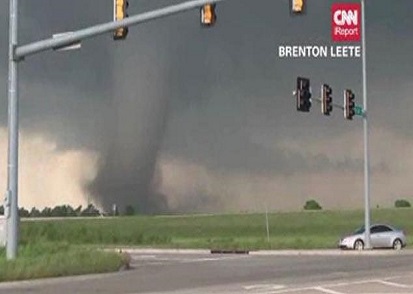ARTICLE
After the Tornado in Oklahoma
POSTED BY WLAS May 21st, 2013 0 COMMENTS
 “The people of Moore should know that their country will remain on the ground, there for them, beside them as long as it takes,” President Obama said Tuesday morning, as crews were still sifting through the wreckage left by a tornado whose size and scope— it spent a full forty minutes ripping up everything on the ground—startled even those in Oklahoma who, as Obama said, “are better prepared for this type of storm than most.” The wind may have reached two hundred miles an hour; its place on the enhanced Fujita scale is at least four, and may be changed to five, which is as high as it goes. (Patrick Di Justo has an explanation of the Fujita scale.) But the number that mattered more to those on the ground was that of the dead, and it is still unclear—it jumped around in the night, settling on twenty-four confirmed dead, many missing, hundreds injured.
“The people of Moore should know that their country will remain on the ground, there for them, beside them as long as it takes,” President Obama said Tuesday morning, as crews were still sifting through the wreckage left by a tornado whose size and scope— it spent a full forty minutes ripping up everything on the ground—startled even those in Oklahoma who, as Obama said, “are better prepared for this type of storm than most.” The wind may have reached two hundred miles an hour; its place on the enhanced Fujita scale is at least four, and may be changed to five, which is as high as it goes. (Patrick Di Justo has an explanation of the Fujita scale.) But the number that mattered more to those on the ground was that of the dead, and it is still unclear—it jumped around in the night, settling on twenty-four confirmed dead, many missing, hundreds injured.
“Among the victims were young children trying to take shelter in the safest place they knew: their school,” Obama said. Their sense of place wasn’t wrong. Some of the wonder was that the storm hadn’t hit after dark, when people were asleep in rooms like the one belonging to a girl with a butterfly lamp that was torn open, which served as a backdrop for an NBC team, like a half-built stage set missing a roof and walls. At night, many grownups wouldn’t have been at work and out of the tornado’s path. There was also intense gratitude toward the adults who were there, and exactly where they needed to be, especially the teachers in those schools.
Because of Oklahoma’s geology, few houses there have deep basements, and so the children and school staffs seem to have mostly taken shelter in hallways that were known to be better fortified, as well as in bathrooms and closets. For a storm a little less strong than this, that would have been enough. In some schools it was: Briarwood, where the teachers put their bodies over the children and told them to hold their backpacks over their heads—mini-rooftops. At AgapeLand Learning Center, according to the Times, teachers “hustled some 15 children into two bathrooms, draping them with a protective covering.” The roof of was blown off, and some debris fell on the tarp, but the children weren’t hurt. Underneath, the teachers were leading them in singing “You Are My Sunshine.”
At Sandy Hook Elementary School, in a different sort of storm, teachers were huddled in similar spaces, telling children to be as quiet as they could. But silent or singing, the impulse is the same; the teachers were the protective covering for many children. And, as in Newtown, there were tragedies that even the bravest teachers couldn’t stop; at Plaza Towers Elementary School, the tornado systematically took down the walls. Rhonda Crosswhite, a teacher, told NBC that she’d worried that the half dozen children she was sheltering with in a bathroom couldn’t hear her over the storm. “One of my little boys just said, he just kept saying, ‘I love you, I love you, please don’t die with me, please don’t die with me.” She told him they wouldn’t; she was right, and some of the most powerful images from Moore were of the children retrieved from the ruins—they “were lifting walls up and kids were coming out,” a police officer told the Chicago Tribune. But at least seven children died at the school. The medical examiner said that they’d drowned, trapped with water and wreckage.
“In some cases, there will be enormous grief that has to be absorbed, but you will not travel that path alone,” Obama said. What does that mean, though, in practical terms? Obama is good at comfort in a disaster, but how good will the Administration be in organizing aid? And how good will Congress be about authorizing money for it? Some basic response are in place: Obama signed a major disaster declaration for Oklahoma, which frees up federal aid; he said that the head of the Federal Emergency and Management Agency, Craig Fugate, was on his way, and that Janet Napolitano, the Secretary of Homeland Security, had been told to do whatever she could. They’ve got to get it right; there is a town where blocks of houses are empty lots that look like they’ve been scrubbed and scoured. There are also political traps to contend with, like the sequester, though may be more of a long-term issue than an immediate one. (FEMA hasn’t used up this year’s budget yet.) Does it matter that Oklahoma’s senators voted against aid for Sandy? Only in how we view them, not in terms of how quickly and sensibly we can get help to the people of Moore, who need it now.
“We will get through this, we will overcome,” Governor Mary Fallin, of Oklahoma, said a couple of hours after the President spoke. She talked about what the teachers had done, and about the relief workers, who, she said, would lift up “every piece of debris” to see “if there might be someone who survived the storm.” Their efforts had been complicated because street signs and other markers had been ripped away, making it difficult “to determine what part of the community we might be in.” Fugate, of FEMA, came out next, and talked about what people in the area should do: text instead of making cell-phone calls, give cash instead of goods. And “let people know you are O.K.”
Leave a Reply







